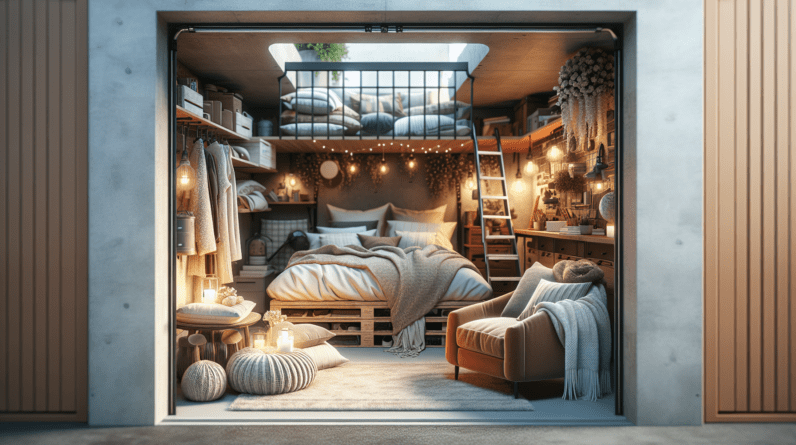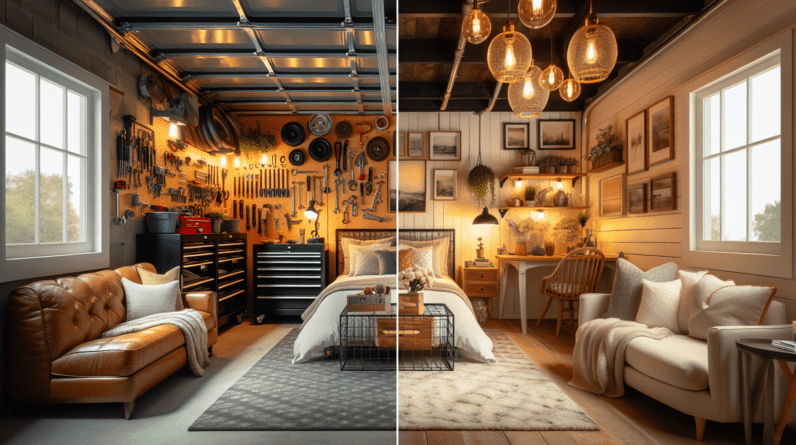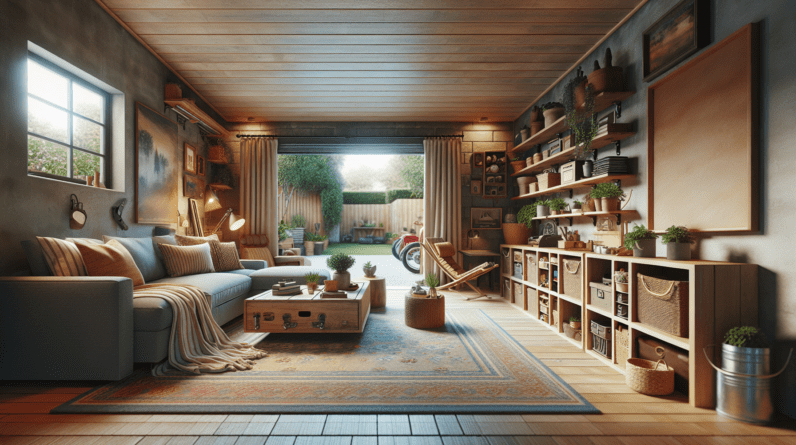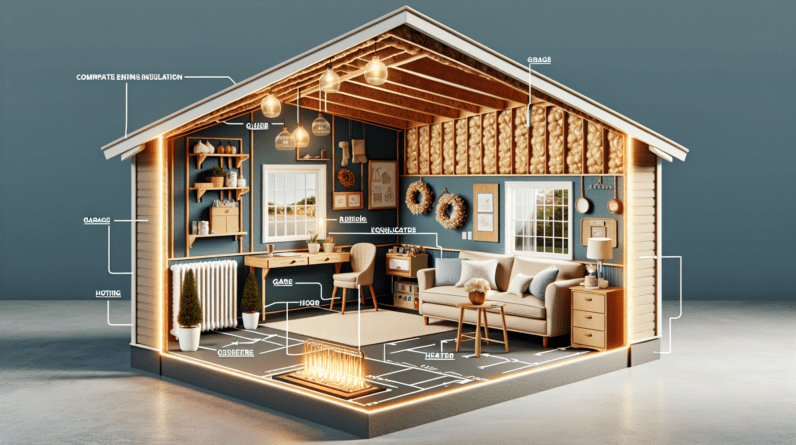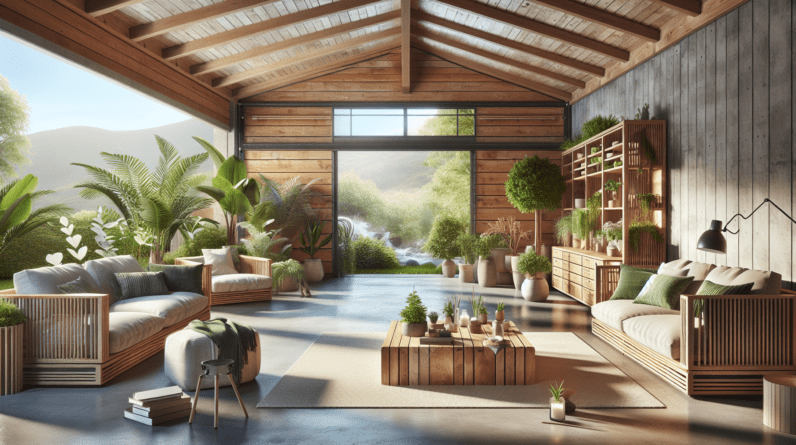
Are you looking to transform your garage into a stylish and eco-friendly guest room? Look no further! In this article, we will explore the exciting world of garage makeovers, focusing on sustainability and eco-friendly designs. From my research, I have discovered innovative ideas and practical tips that will not only maximize the space but also minimize your environmental impact. Whether you want to create a cozy space for visiting friends and family, or generate some extra income through short-term rentals, these garage makeovers are sure to inspire you. So, grab some coffee, sit back, and let’s embark on a journey towards a greener and more inviting garage guest room.
Design and Layout
When it comes to designing and laying out a sustainable space, there are several key factors to consider. Choosing sustainable materials is an excellent place to start. Opting for materials that are environmentally friendly and have a low carbon footprint can significantly reduce the impact of your construction or renovation project. From my experience, materials such as reclaimed wood, recycled glass, and bamboo are excellent choices.
Another essential aspect of sustainable design is optimizing natural light. By incorporating large windows, skylights, and light tubes into your space, you can minimize the need for artificial lighting during the day. This not only reduces your energy consumption but also creates a bright and inviting atmosphere. According to my research, spaces filled with natural light have been shown to improve mood and productivity.
Creating a well-ventilated space is crucial for maintaining good indoor air quality and reducing the reliance on air conditioning systems. You can achieve this by incorporating features such as operable windows and installing efficient ventilation systems. This allows for better air circulation and helps to remove toxins and pollutants from your living environment. Additionally, integrating ceiling fans can further enhance the airflow and provide a cooling effect in the warmer months.
Efficient utilization of space is another aspect of sustainable design that should not be overlooked. By maximizing the functionality of each area, you can minimize wasted space and reduce the need for additional square footage. Built-in storage solutions, multifunctional furniture, and thoughtful room layouts can all contribute to a more sustainable and efficient use of space.
Insulation and Energy Efficiency
Insulation and energy efficiency play a significant role in reducing energy consumption and creating a comfortable living environment. Upgrading insulation is a cost-effective way to improve energy efficiency. By adding insulation to walls, roofs, and floors, you can prevent heat loss in the winter and reduce the need for heating systems. Insulation also helps to keep your space cool in the summer by preventing heat gain.
Installing energy-efficient windows is another essential aspect of creating an energy-efficient space. Energy-efficient windows are designed to minimize heat transfer, keeping your home warmer in the winter and cooler in the summer. These windows often feature double or triple glazing, low-emissivity coatings, and insulated frames.
Utilizing smart home technology can further enhance energy efficiency. Smart thermostats allow you to control your heating and cooling systems remotely and adjust temperatures based on occupancy. This ensures that energy is not wasted when no one is present in the room. Additionally, implementing efficient lighting solutions such as LED bulbs and smart lighting controls can significantly reduce electricity usage.
Heating and Cooling Systems
Exploring eco-friendly heating options is crucial for reducing greenhouse gas emissions. From my research, I found that options such as geothermal heating, solar thermal systems, and biomass boilers are all viable alternatives to traditional heating methods. These systems utilize renewable energy sources, reducing the reliance on fossil fuels.
Utilizing energy-efficient cooling methods is equally important for reducing energy consumption. Installing ceiling fans, using window coverings to block out direct sunlight, and incorporating proper insulation are effective strategies. Additionally, considering natural ventilation by strategically placing windows and using cross-ventilation techniques can help cool your space without the need for air conditioning.
Maximizing natural ventilation is another key aspect to consider. By incorporating operable windows, skylights, and ventilation systems, you can take advantage of natural breezes and airflow to cool your space. This not only reduces the need for mechanical cooling systems but also contributes to a healthier indoor environment.
Integrating solar-powered systems for heating and cooling can be a game-changer in terms of sustainability. Solar water heaters and solar air conditioning systems harness the power of the sun to generate energy, reducing your reliance on electricity and fossil fuels.
Water Conservation
Water conservation is a critical aspect of sustainable living. By implementing various strategies, you can significantly reduce your water usage and contribute to a more environmentally friendly lifestyle.
Installing low-flow fixtures such as faucets, showerheads, and toilets is an effective way to conserve water. These fixtures reduce the flow rate without compromising performance, saving both water and energy. According to our data, switching to low-flow fixtures can reduce water usage by up to 50%.
Harvesting rainwater for non-potable use is another sustainable practice. By collecting rainwater from the roof and storing it in tanks, you can utilize this water for purposes such as watering plants, outdoor cleaning, and flushing toilets. Implementing a rainwater harvesting system not only conserves water but also reduces the strain on municipal water supplies.
Creating a sustainable landscaping design is essential for water conservation. By choosing native and drought-resistant plants, you can minimize the need for watering. Additionally, grouping plants with similar water needs together and incorporating efficient irrigation systems such as drip irrigation can further reduce water usage.
Implementing greywater recycling systems is another effective way to conserve water. Greywater refers to wastewater generated from non-toilet fixtures such as sinks, showers, and washing machines. By treating and reusing this water for purposes such as irrigation or toilet flushing, you can significantly reduce your overall water consumption.
Green Interior Design
Green interior design focuses on choosing materials and furnishings that are safe for both the environment and human health. By making conscious choices, you can create a healthy and sustainable living space.
Choosing non-toxic paint and finishes is an essential aspect of green interior design. Conventional paints and finishes often contain volatile organic compounds (VOCs) that release harmful toxins into the air. Opting for low or zero VOC paints and finishes ensures a healthier indoor air quality.
Opting for eco-friendly furniture and decor is another way to create a sustainable interior. Look for pieces made from reclaimed or sustainably sourced materials. Additionally, choosing furniture made from natural fibers and avoiding treatments with flame retardants and other harmful chemicals is recommended.
Utilizing sustainable flooring options is crucial for reducing the environmental impact of your space. Materials such as bamboo, cork, and reclaimed wood are excellent choices as they are renewable and have a lower carbon footprint compared to traditional flooring materials.
Bringing nature indoors with plants not only enhances the aesthetics of your space but also provides numerous benefits. Plants improve indoor air quality by absorbing harmful pollutants and releasing oxygen. Additionally, they can contribute to a sense of calm and well-being, creating a more inviting atmosphere.
Waste Management and Recycling
Proper waste management and recycling are essential for minimizing our impact on the environment. By implementing effective strategies, you can significantly reduce the amount of waste sent to landfills.
Setting up a composting system is a great way to divert organic waste from the landfill. Composting allows food scraps, yard trimmings, and other organic materials to decompose and create nutrient-rich compost that can be used to fertilize plants and gardens. Composting not only reduces waste but also helps to enrich the soil.
Implementing a recycling station is another critical aspect of waste management. Setting up clearly labeled bins for different types of recyclables such as paper, plastic, glass, and metal encourages proper recycling practices. Additionally, considering local recycling programs and regulations can ensure that your recycling efforts are effective and in line with the community’s recycling goals.
Avoiding single-use plastics is an essential step towards reducing waste. By opting for reusable alternatives such as stainless steel water bottles, cloth shopping bags, and glass food storage containers, you can significantly reduce the amount of plastic waste generated.
Optimizing waste reduction strategies is another way to minimize waste. This can involve practices such as reducing packaging waste by buying in bulk, donating unwanted items instead of throwing them away, and practicing mindful consumption by buying only what you need.
Renewable Energy Sources
Renewable energy sources are a key component of sustainable living. By harnessing the power of natural resources, we can reduce our dependence on fossil fuels and decrease our carbon footprint.
Installing solar panels is one of the most common and effective ways to generate renewable energy. Solar panels convert sunlight into electricity, which can be used to power various appliances and systems in your home. Not only does this reduce your reliance on the grid, but it also allows you to generate clean energy and potentially earn energy credits through net metering.
Exploring wind power options is another avenue to consider. If you have access to sufficient wind resources, installing a wind turbine can generate electricity to power your home. Wind power is a clean and renewable energy source that can significantly reduce your reliance on traditional grid electricity.
Utilizing geothermal energy is another sustainable option for heating and cooling. Geothermal heat pumps utilize the stable temperature of the ground to provide efficient heating and cooling for your home. By tapping into the earth’s natural heat, you can reduce energy consumption and lower your carbon footprint.
Integrating hydropower systems is another possibility, especially if you have a water source on your property. Hydropower harnesses the energy of flowing or falling water to generate electricity. Small-scale hydropower systems can be installed in streams, rivers, or even on your property’s water source, providing a consistent and renewable energy source.
Smart Technology Integration
Smart technology integration can significantly enhance energy efficiency and automation in your home. By leveraging smart devices and systems, you can optimize energy consumption and simplify daily tasks.
Automating energy usage with smart thermostats is a smart way to minimize energy waste. Smart thermostats allow you to program and control your heating and cooling systems remotely. This means that you can adjust the temperature based on occupancy, ensuring that energy is not wasted when no one is home.
Controlling lighting with motion sensors is another smart solution. Motion sensors detect movement and automatically turn on lights, eliminating the need to manually switch them on and off. This prevents lights from being left on in unoccupied rooms, saving both energy and money.
Implementing smart monitoring systems can provide real-time information on energy usage and help identify areas where energy can be better managed. By tracking energy consumption and receiving notifications about potential waste or inefficiency, you can make more informed decisions about energy usage and optimize your energy consumption.
Optimizing energy consumption through automation is another advantage of smart technology integration. By connecting various devices and systems through a central hub, you can create rules and schedules that automatically adjust energy usage based on specific conditions. For example, you can program your home to lower the temperature when you leave and raise it when you return, ensuring comfort while minimizing wasted energy.
Sustainable Landscaping
Sustainable landscaping involves designing and maintaining outdoor spaces in an environmentally friendly and resource-efficient manner. By implementing sustainable practices, you can create a beautiful and eco-friendly landscape.
Choosing native and drought-resistant plants is an essential aspect of sustainable landscaping. Native plants are adapted to the local climate and require less water, fertilizer, and pesticides compared to non-native species. Additionally, drought-resistant plants can withstand periods of low rainfall without the need for excessive watering.
Implementing efficient irrigation systems is crucial for water conservation in your landscape. Drip irrigation, for example, delivers water directly to the roots of plants, minimizing water loss due to evaporation and runoff. Additionally, using rain sensors or soil moisture sensors can help ensure that your irrigation system operates only when necessary.
Creating a pollinator-friendly environment is not only beneficial for the ecosystem but also adds beauty and diversity to your landscape. Including a variety of flowering plants that attract bees, butterflies, and other pollinators can support biodiversity and contribute to the health of our ecosystems.
Utilizing permeable surfaces is an effective way to reduce water runoff and prevent soil erosion. Permeable surfaces such as gravel, permeable pavers, or porous concrete allow rainwater to infiltrate the ground rather than running off into storm drains. This helps to recharge groundwater and reduces the burden on municipal stormwater systems.
Green Building Certifications
Green building certifications provide recognition for buildings that meet specific sustainability criteria. These certifications serve as a standard for sustainable construction and can provide numerous benefits for both homeowners and the environment.
Exploring LEED certification is a great starting point. LEED (Leadership in Energy and Environmental Design) is a globally recognized certification system that assesses a building’s energy efficiency, water usage, materials, indoor environmental quality, and sustainability practices. Achieving LEED certification demonstrates your commitment to sustainability and can enhance the value and marketability of your property.
Understanding the benefits of Green Star certification is also important. Green Star is an Australian sustainability rating system that evaluates the environmental impact of buildings over their lifecycle. It covers various aspects such as energy usage, water management, materials selection, and indoor environment quality. Green Star certification can provide a competitive edge and demonstrate a high level of sustainability performance.
Certifications for sustainable construction materials are another aspect to consider. Look for certifications such as Forest Stewardship Council (FSC) for responsibly sourced wood, Cradle to Cradle for environmentally safe and socially responsible products, and GREENGUARD for low-emitting materials. These certifications ensure that the materials used in your project meet stringent sustainable and environmental standards.
Investigating local green building programs is also worth considering. Many cities and municipalities have their own green building programs or incentives that promote sustainable construction practices. These programs often provide resources, incentives, and support to individuals and businesses interested in sustainable building, making it easier to achieve your sustainability goals.
In conclusion, eco-friendly and sustainable garage guest room makeovers involve careful consideration of various aspects of design and construction. By choosing sustainable materials, optimizing natural light, utilizing efficient heating and cooling systems, conserving water, creating a green interior, implementing waste management and recycling strategies, incorporating renewable energy sources, integrating smart technology, designing sustainable landscapes, and exploring green building certifications, you can transform your garage into a sustainable and inviting guest room that aligns with your environmental goals. Remember, every small step towards sustainability can make a significant difference in preserving our planet for future generations.



